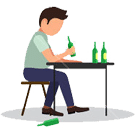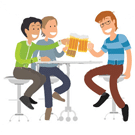Alcoholism/Alcohol Use Disorder

-
Alcoholism is no longer the preferred term for alcohol abuse or addiction. Instead, it is now known as alcohol use disorder (AUD). This disorder affects approximately 16 million people in the United States, more than 6 percent of the population, and includes every race, religion and ethnicity.
-
While more men than women suffer from AUD, women actually face greater health risks. Not only can drinking during pregnancy cause permanent damage to the fetus, but AUD can increase the rate of breast cancer, heart and liver disease in females.
-
Health risks for both genders due to AUD include increased risk for accidents, assaults, hypertension, cognitive disorders, risky sexual behaviors and various types of cancers. AUD can shorten a person’s lifespan by decades. It is a serious public health problem as well as a personal one.
NIAAA
The National Institute on Alcohol Abuse and Alcoholism has a great description of the medical diagnosis of AUD.
Mayo Clinic
Alcohol use disorder as explained by the Mayo Clinic complete with advice for receiving care.
U.S. National Library of Medicine
MedlinePlus is trusted health information provided by the U.S. National Library of Medicine.
APA
The American Psychological Association explains alcohol use disorders and their treatment.
Cleveland Clinic
The Cleveland Clinic's Center for Continuing Education has a large section detailing Alcohol Use Disorders.
AAFP
American Family Physician information on medications for alcohol use disorder.
Authorities on Alcoholism

-
It is crucial to seek help or information from authorities on alcoholism, as they are the gold standard. These organizations have the latest treatment options available as well as up-to-date statistics on the most successful treatment options. They refer to well-conducted studies for their data, so give you the best resources in your own quest in finding the best types of treatment and rehabilitation for yourself or a loved one. Seeking information from non-authoritative sources can lead to missteps in the path to AUD recovery, costing you both time, money and health.
-
Take a look at these authorities on alcoholism for a wealth of information on signs, AUD treatment and more:
NIH
The National Institutes of Health is a medical research agency division of the U.S. Dept. of Health and Human Services.
AAAP
The American Academy of Addiction Psychiatry is a professional organization dedicated to sharing of research and clinical treatment.
APA
The American Psychological Association uses psychology to benefits people's lives.
ASAM
American Society of Addiction Medicine is a membership organization for education and advocacy of addiction.
NAADAC
NAADAC is the association and one of the accrediting bodies for addiction professionals.
NASW
The National Associaion for Social Workers provides resources for social workers who deal with alcoholics.
NIAAA
Rethinking Drinking is a helpful site provided by the NIAAA for those thinking about making a change to their health.
Free Alcoholism Resources

-
Getting help for alcoholism doesn’t always have to cost money, and these free resources can be used alone or in combination with other treatment options for lasting recovery.
-
Self-help groups like Alcoholics Anonymous exist for the alcoholic, and other groups like Al-Anon Family Groups are there for the family and friends of alcoholics. If you are looking for a free treatment finder or other resources, take a look at the SAMHSA site.
Alcoholics Anonymous
Alcoholics Anonymous is the longest running 'anonymous' program and welcomes pill addicts who are also addicted to alcohol.
SAMHSA
SAMHSA has a free treatment finder and other tools for those looking for help with their addiction.
Al-Anon
Find free meetings and helpful resources for family and friends of alcoholics.
SMART Recovery
Program that offers meetings, tools and books as an alternative to alcohol treatment.
Cocaine Anonymous
Cocaine Anonymous is a 12-step support group for those addicted to cocaine and all other mind-altering substances.
Narcotics Anonymous
Narcotics Anonymous is a worldwide organization providing tools for a better way of life for those addicted to narcotic substances.
BAC Calculator
Blood alcohol content or blood alcohol concentration is a means to measure the amount of alcohol present in a person’s bloodstream.
Alcoholic Quiz
An assessment test is a simple battery of questions about alcoholism that will help you determine if you have a drinking problem, or worse.
Statistics on Alcoholism
According to 2015 study by the National Institute on Alcohol Abuse and Alcoholism (NIAAA), nearly 27 percent of people aged 18 and up reported they had engaged in binge drinking – defined as consumption of four drinks for women and five drinks for men in a two-hour period -in the previous month.
Excess alcohol use kills about 88,000 people per year. Approximately 4,300 of those deaths occurred in people under the age of 21, the legal drinking age.
Ten percent of U.S. children live with an parent suffering from AUD.
AUD results in approximately $249 billion per year in lost economic productivity, an average of $2.05 per drink. More than 75 percent of these costs relate to binge drinking.
Genetics plays a role in AUD, making up about half of risk factors. That does not mean that just because someone has a family history of AUD that they will experience a drinking problem, but it is something for such people to take into consideration if they decide to drink.
Alcohol and Substance Abuse at Work

- Mixing alcohol and drugs at work can cost a person their job and jeopardize future employment. This behavior also costs employers millions of dollars annually in lost time and productivity.
- In some cases, people with AUD may fall under Americans with Disabilities Act (ADA) protection. That is not true of those who use illegal drugs while on the job. According to the U.S. Department of Justice’s Civil Rights division, an alcoholic is protected under ADA is they are qualified to perform a job’s essential functions. However, an employer may “discipline, discharge or deny employment” to a person whose alcohol use adversely affects either their job performance or their conduct. Employers can prohibit workplace alcohol use and require that workers not be under the influence of alcohol while working.
Here are some important resources for employers and employees:
OPM
The Office of Personnel Management provides a supervisor handbook to deal with alcoholism in the workplace.
Know your rights
SAMSHA resource detailing your workplace rights to protect you from discrimination for your alcohol or drug problem.
Employer's guide to dealing with sub abuse
tips for employers on how to develop a substance abuse program for employees that works
responding to employee sub abuse
judgements on past cases showing how addiction falls under the ADA
Society for Human Resource Management
article detailing what to do about substance abuse in the workplace and how prevalent the problem is
Substance abuse under the ADA
overview of legal obligations for employers and employees
Campus Alcoholism Resources

Many young adults begin drinking seriously while at college, even though they are under the legal drinking age. A campus “party” atmosphere and the lack of parental authority can lead to binge drinking and terrible consequences. Most parents have heard of deaths occurring on college campuses because of excessive drinking. Sexual assault is more likely when one or both parties are drunk. So are deaths or severe injuries from motor vehicle or other accidents. Roughly 25 percent of students report academic consequences due to drinking, and fully 20 percent of college students meet AUD criteria.
Fortunately, colleges and universities are finally coming to terms with the frequency and dangers of drinking on campus. Some schools are eliminating or severely restricting the activities of fraternities, as Greek life tends toward a hotbed of drinking culture. While campus resources to combat AUD vary by school, most colleges offer programs helping students struggling with the disease either on-campus or through off-campus professional services. They may also offer specific sober recreational and social activities to keep students engaged and away from alcohol. Check with your student’s college health department to see what services a specific school offers.
Here are some helpful resources from colleges around the U.S.:
Dartmouth
Collaborative effort of multiple schools on the Dartmouth campus to address alcohol, tobacco, and other related drug issues.
Daytona State
Daytona State College offers individual counseling for addiction issues and community resources.
Florida Institute of Technology
whitepaper about the effects of alcohol abuse and drugs on college students
Gateway Community College
links to local and campus resources for student wellness regarding addiction
James Madison University
talks about on-campus AA meetings and other health related topics
Lake Superior College
Tri-campus Community Coalition on Student Drinking addresses dangerous student use of alcohol.
Nichols State University
quick resource center for those looking for help with addictions and detox
Resources for Parents

- Seeing your child struggling with AUD is heartbreaking, and you may not know where to turn. In teenagers, drinking is often used as a method of self-medication to deal with mental and emotional issues. The NAIAA estimates that 623,000 young people ages 12 to 17 suffer from AUD. Nearly half of all teenagers report being drunk at least once by their senior year. Not only does teen drinking affect a child’s development but may pave the way for AUD in adulthood.
- It is essential that parents talk to their children about drinking and become good role models. Don’t fool yourself with “not my child” syndrome – any child can develop AUD. Monitor your child’s behavior and know who their friends are. If there is a history of alcoholism in your family, let your children know they are at greater risk and may never be able to drink normally.
- Some high schools may offer resources for teens with drinking problems. Other resources include your local hospital, as well as therapists and counselors specializing in teenage alcohol and drug abuse. Don’t wait until your teenager’s drinking develops in full-fledged AUD. Seek help and intervention as soon as possible.
Here are some helpful sites with information for parents and caregivers:
Teen Mental Health
This website helps teens as they transition in school, giving them tips on topics such as time management and mental health.
Teen Health
Site dedicated to helping teens be healthy and deal with changes in their body, mind and emotions.
What Works 4 U
This site has a helpline, a share center and a place to share and learn from others what works for them with their mental health.
AACAP
American Academy of Child and Adolescent Psychiatry website has lots of sections, this one is about teens and alcohol and other drugs.
NIDA for Teens
The National Institute for Drug Abuse has a whole section for parents of teens, with videos, scientific facts and more.
SAHM
The Society for Adolescent Health and Medicine has a site dedicated to providing information, along with membership for professionals in the field.
College Drinking Prevention
Provides research-based information on binge drinking and other alcohol use of college-aged students.
Family Doctor
This website, operated by the American Academy of Family Physicians, provides scientifically accurate information from a family medicine perspective.
Stop Alcohol Abuse
Provides research and information on prevention, as well as videos specifically designed for college-bound youth
Healthy Children
Sponsored by the American Academy of Pediatrics, this website provides resources for treatment for drug and alcohol abuse for teens.
Top Ten Tips for Getting Alcohol Addiction Help

Whether you or a loved are affected by AUD, it’s important to get help. Here are some basic do’s and don’ts:
- Accept the fact that you or your loved one has a problem with alcohol. Denial is not a solution.
- Learn about AUD and its signs and symptoms.
- Contact an alcohol treatment center or therapist.
- Avoid people who may tempt you to drink. This may involve forging new social priorities and connections.
- If the problem involves a loved one, don’t become an enabler or a co-dependent.
- Do not try to talk to a loved one about alcoholism treatment options when they are drunk. Wait until they are sober, or at least not deeply under the influence.
- Do not drink around a loved one with an alcohol issue.
- Do not provide your loved one with money unless it is for treatment.
- Do not shame or scold your loved one. This is not helpful.
- If your loved one refuses to face the reality of their AUD, discuss staging an intervention with a counselor and family members and close friends.
Alcoholism can ruin a person’s life and cause great harm to their family. However, there are millions of people who undergo treatment for alcoholism and never drink again. The sooner a person drinking to excess, or their loved ones, seek information and treatment, the better the possible outcome. Do not let shame stop you from seeking help. People from every walk of life have struggled with AUD, and most will win their battle. There is no cure for AUD, but there are countless examples of recovering alcoholics who lead active, fulfilling, sober lives. Resources are available. Don’t despair, and never give up.
Sources:
-
https://www.niaaa.nih.gov/alcohol-health/overview-alcohol-consumption/alcohol-use-disorders
-
https://www.ada.gov/copsq7a.htm
-
http://time.com/4784875/fraternities-timothy-piazza/
-
https://www.washingtonpost.com/news/parenting/wp/2017/02/03/how-to-talk-to-your-kids-about-family-addiction/?utm_term=.d99d8e059021
-
https://www.cdc.gov/alcohol/fact-sheets/alcohol-use.htm

